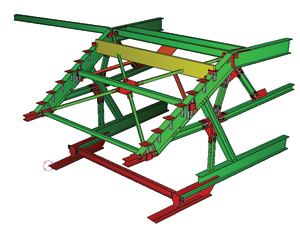The main lesson learned by the construction manager who recently completed a pioneering four-year, BIM-enabled project to build a replacement ballpark for the New York Yankees is “the more trades modeling, the merrier,” says James Barrett, manager of virtual design and construction for Turner Construction Co., the CM at-risk. But more doesn’t necessarily mean more complex, in terms of interoperabilty, anyway. Building on the experiences with the Yankees project, Barrett says Turner is satisfied for now to see subcontractors building their own models and working with their tools of choice, at their preferred levels of detail beyond a minimum standard, as long as they deliver models and revisions that can be coordinated in Autodesk’s Navisworks product line. “It’s the ‘lingua franca’ of our projects,” says Barrett.


“The more trades you can get to model, the better that coordination process is going to be,” says Barrett. On a long-running, high-profile construction job like a new ballpark for the Yankees, whose construction costs were $1.1 billion, coordination was king.
The Yankees’ construction BIM was a leader in developing protocols for applying 3D digital modeling to coordinate trade contributions to a facility. It was born in early 2005 shortly after the project team formed and agreed to coordinate disciplines through 3D modeling and BIM. The team consisted of the owner, Yankee Stadium LLC; New York City-based development manager Tishman Speyer; architect HOK Sport, Kansas City, Mo.; structural engineer Thornton Tomasetti, New York City; mechanical, electrical and plumbing engineer ME Engineering, Rochester, N.Y., and construction manager Turner Construction Co., New York City. Background architectural-design and concrete-placement models were created in AutoCAD Architectural. Tekla and 3D AutoCAD were used for structural steel and detailing and AutoCAD ABS for mechanical, electrical, plumbing and fire protection.
“Tishman Speyer, with the design team, pushed it through to the next level requirement that all of the trades produce shop drawings in models that could be incorporated into Navisworks,” says Michael J. Squarzini, the principal at Thornton Tomasetti in charge of the structural design team. “Tishman Speyer wanted to leverage BIM from a construction standpoint. Turner Construction became master modeler through Navisworks clash detection during the design stage.”
The team realized that trying to engineer a master BIM for direct digital exchange of fabrication level construction information was too high a bar, given the state of technology. A more practical and efficient approach was for each trade to create its own purpose-built models for generating shop drawings and driving fabrication.
“There is no one true model,” Barrett says. “The closest you get to that is a consolidated Navisworks model. What you find is that it is as easy to rebuild the model as it is to figure out how somebody else built it. You have to figure out the layering structure, [and] how the assembly codes are organized. You have origin point issues and questions like ‘is the curtain wall broken down floor by floor or area by area?’ It gets cumbersome trying to trace back how it was built. The activity of creating a model, if you are proficient, is a relatively easy process but the thought process that goes into it is completely different. That’s the value-add.”
In one lesson learned, at the outset of the project, Turner specified the plumbing model only capture 4-in.-dia lines and larger because it thought more detail was unnecessary. But project managers quickly realized the mechanical-electrical-plumbing contractor needed to model to a finer level of information, as his model would ultimately drive the generation of shop drawings and fabrication.
Turner dropped its idea of dictating model resolution, beyond requiring models represent solid surfaces reflecting actual dimensions, and requiring regularly scheduled submissions of designs and revisions that could be integrated into a Navisworks BIM. Barrett says Turner also not only requires the trades use Navisworks, but, by special arrangement with Autodesk, Turner supplies it.
“We have over 400 licenses in Turner,” Barrett says. By special arrangement with Autodesk, Turner “rents” licenses to each participating organization. “It helps a lot. You get a wider group brought into the process,” Barrett says, adding that other than Navisworks, “our policy is not to mandate any particular process or software. That could be a barrier to participation. Use whatever works best for you.”
PRINCIPAL, THORNTON TOMASETTI
During the course of the project, Turner’s definition of its BIM collaboration policy developed into a three-page virtual-design-and-construction provision that is now a standard element of Turner contracts, elaborated on by a project-specific BIM Execution Plan. One recently drafted example goes on for an additional seven pages. The plan defines collaboration team roles and responsibilities by trade. It also make clear that in addition to their installations in the finished structure, another deliverable for each trade is their contribution to making the BIM-based coordination process succeed.
The coordination problems that did make it to the jobsite during construction invariably involved elements that had not been modeled to fabrication stages of development. “We put in all the concrete, the cast-in-place and precast, but the concrete trades didn’t feed an actual fabrication model into it,” says Squarzini.
That came back to haunt the team when the last set of precast concrete beams on one of the upper levels required a deeper stem than expected due to rebar congestion. That brought it into conflict with steel cross bracing in 15 bays.
“The concrete was already fabricated...but we caught it before it went in, and that was good. It could have showed up on site and we would have been standing around saying, ‘holy cow, now that’s a problem,’” says Squarzini. The bracing was redone and bigger problems were avoided, but unlike a problem avoided in virtual preconstruction conflict resolution, this one still had a six-figure price tag.
“From Yankee Stadium forward we have modeled the precast,” says Erleen Hatfield, the lead BIM coordinator on the project for Thornton Tomasetti. “Adding precast into the BIM model is definitely a lesson learned.”
At the time the problem arose, precast modeling software was not well developed, Squarzini says. Now it is and Squarzini expects precasters to use it.
Other modeling gaps were less dramatic, but still led to complications now seen in hindsight as easily avoidable through BIM coordination. Lighting fixtures—recessed ceiling can lamps—were at first deemed an insignificant detail in the scheme of things, but the failure to model them was regretted later as workers struggled to work around them. Likewise the drywall’s light-metal framing, particularly the cross-bracing in soffits.
“Normally you would say, ‘why would you need to model drywall?’ says Barrett, who believes “the more you model, the merrier. Probably 90% of the project, if you could implant it there in the model, there would be beneficial return.” He says he is a big proponent of early trade input and lots of detail.
Barrett says Turner believes enhancing BIM skills of subs is so important that it is considering offering them modeling services, even for non-Turner jobs. “Our preferences is that subcontractors develop the skills. When they own the model they find new ways to use it and improve their processes and efficiency,” which is better for everyone, he says.
“Everybody went into the Yankees project knowing that we were pushing the boundaries at the time in BIM,” adds Squarzini. “The experience has solidified my thinking. This is the future. This is where it is going.”


Post a comment to this article
Report Abusive Comment